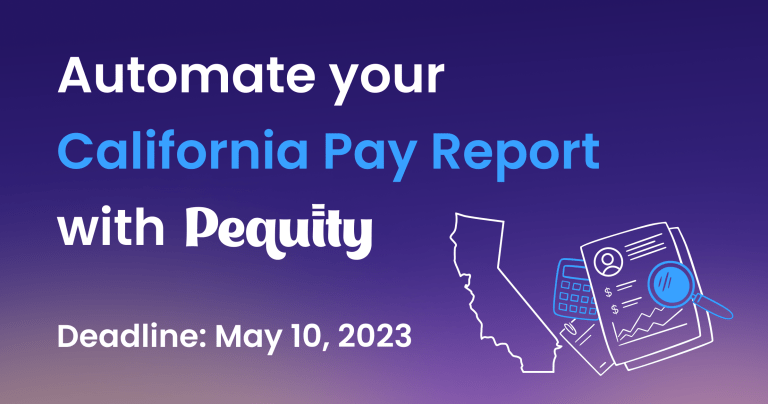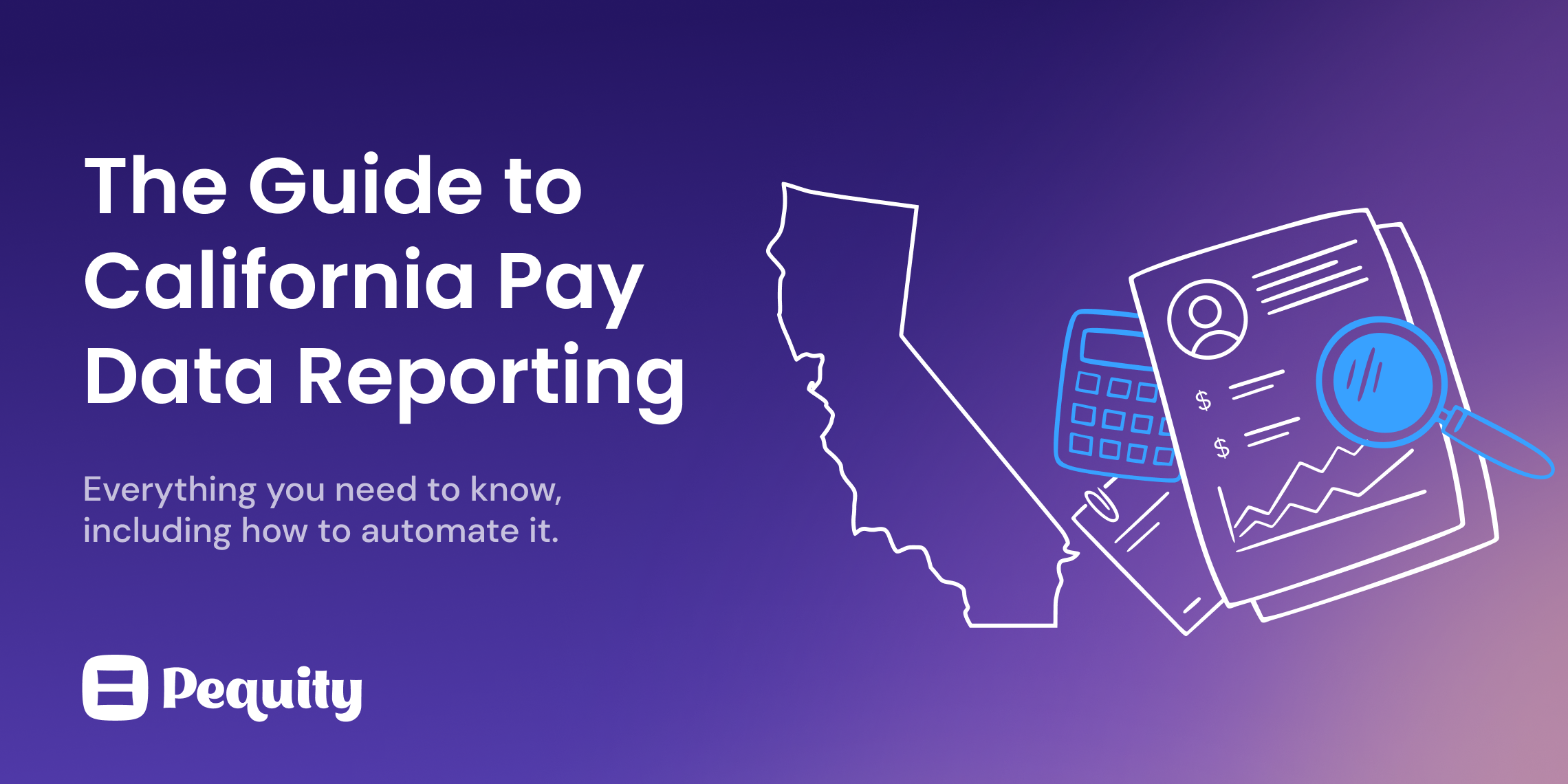Employers in California that meet a certain size threshold must annually submit reports containing pay data for their employees from the previous calendar year. In this guide, we will cover the California pay reporting law, how to create a CA pay data report, who’s required to report, and how you can automate your California pay data report.
What are the requirements of the California pay data reporting law?
All employers with over 100 employees or contractors, who have at least 1 employee in California, are required to submit a pay report to the California Civil Rights Department (CRD). The deadline is May 10, 2023, and the report must be formatted in compliance with the California Civil Rights template.
Employees located inside and outside of California are counted when determining whether an employer has 100 or more employees.
Example: An employer that had 50 employees inside California and 50 employees outside of California during the Reporting Year would be required to submit a Payroll Employee Report.

How do employers create and submit a payroll employee report?
The following is a basic overview of the process for Payroll Employee Reports; employers must follow CRD’s specific instructions provided in the portal, user guide, template, and elsewhere in these FAQs (including the FAQ “How do employers submit their CA pay data reports to CRD?”).
- Determine whether the employer is required to file a Payroll Employee Report for Reporting Year 2022. If the employer is required to file, proceed through the following steps.
- Determine the employer’s “Snapshot Period” to identify the employees who will be reported on. Employees assigned to California establishments and/or who work from California must be reported on.
- Determine which establishments the employer has, and gather information about each establishment.
- For all employees in the Snapshot Period, identify each employee’s establishment, pay band, job category, race/ethnicity, sex, pay, pay band, and hours worked.
- Within each establishment, group employees who have the same job category, pay band, and race/ethnicity/sex combination. Some groups may be a group of one if no other employee in the establishment shares that employee’s job category, pay band, race/ethnicity, and sex.
- Within each employee group in each establishment, calculate the total hours worked by the group.
- Within each employee group in each establishment, calculate the group’s mean hourly rate and the group’s median hourly rate.
- Gather additional information about the employer and its establishments, such as the employer’s address on file with the California Employment Development Department (EDD), total number of employees in the United States, total number of employees in California, Federal Employer Identification Number (FEIN), California Employer Identification Number (SEIN), North American Industry Classification System (NAICS) code(s), DUNS Number, and whether the employer is a state contractor.
- Register in the portal and build the report. First, in the portal, provide information about the employer and, if relevant, its parent company, as well as information on all affiliated entities included in the report (Employer Info and Submission Info). Next, provide establishment-level and employee-level information (Establishment and Employee Details) by uploading an Excel file by using CRD’s template, uploading a .CSV file, or using the portal’s fillable forms.
- Provide any clarifying remarks in the relevant field(s) and correct any errors identified by the portal.
- Certify the final report and submit by May 10, 2023.
How do employers create and submit a labor contractor employee report?
The following is a basic overview of the pay reporting process for Labor Contractor Employee Reports; employers must follow CRD’s specific instructions provided in the portal, user guide, template, and elsewhere in these FAQs (including the FAQ “How do employers submit their pay data reports to CRD?”).
- Determine whether the employer – that is, the client employer – is required to file a Labor Contractor Employee Report for Reporting Year 2022. If the employer is required to file, proceed through the following steps.
- Determine the “Snapshot Period” for each labor contractor to identify the labor contractor employees who will be reported on. Labor contractor employees assigned to California establishments and/or who work from California must be reported on.
- Determine which establishments the employer has, and gather information about each establishment.
- Determine which labor contractors the employer used, determine which establishments had labor contractor employees, and gather information about each labor contractor and each labor contractor employee. Labor contractors are required to supply necessary information to the client employer.
- For all labor contractor employees in each labor contractor’s Snapshot Period, identify each labor contractor employee’s establishment, pay band, job category, race/ethnicity, sex, pay, and hours worked. Labor contractors are required to provide necessary information to the client employer.
- Within each establishment, group labor contractor employees who have the same job category, pay band, and race/ethnicity/sex combination. Some groups may be a group of one if no other labor contractor employee in the establishment shares that labor contractor employee’s job category, pay band, race/ethnicity, and sex.
- Within each employee group in each establishment, calculate the total hours worked by the group.
- Within each employee group in each establishment, calculate the group’s mean hourly rate and the group’s median hourly rate.
- Gather additional information about the employer and its establishments, such as the employer’s address on file with the California Employment Development Department (EDD), total number of employees in the United States, total number of employees in California, Federal Employer Identification Number (FEIN), California Employer Identification Number (SEIN), North American Industry Classification System (NAICS) code(s), DUNS Number, and whether the employer is a state contractor.
- Register in the portal and build the report. First, in the portal, provide information about the employer and, if relevant, its parent company, as well as information on all affiliated entities included in the report (Employer Info and Submission Info). Next, provide establishment-level and employee-level information (Establishment and Employee Details) by uploading an Excel file by using CRD’s template, uploading a .CSV file, or using the portal’s fillable forms.
- Provide any clarifying remarks in the relevant field(s) and correct any errors identified by the portal.
- Certify the final report and submit by May 10, 2023.
How should employers assign employees to a job category?
Employers should assign each payroll employee/labor contractor employee to one of the following ten job categories:
- Executive or senior level officials and managers
- First or mid-level officials and managers
- Professionals
- Technicians
- Sales workers
- Administrative support workers
- Craft workers
- Operatives
- Laborers and helpers
- Service workers
Which pay bands should an employer use?
For the 2022 Reporting Year (California pay data reports due to CRD in 2023), the pay bands are:
- $19,239 and under
- $19,240 – $24,959
- $24,960 – $32,239
- $32,240 – $41,079
- $41,080 – $53,039
- $53,040 – $68,119
- $68,120 – $87,359
- $87,360 – $112,319
- $112,320 – $144,559
- $144,560 – $186,159
- $186,160 – $239,199
- $239,200 and over
Importantly, the pay bands for the pay data reports due to CRD in 2023 (covering Reporting Year 2022) are the same pay bands used last year. You must use the pay bands listed above, which reflect the most recent pay bands established by the U.S. Bureau of Labor Statistics in the Occupational Employment and Wage Statistics survey.
How should employers report employees’ race and ethnicity?
Employers should follow the EEOC’s long-standing instructions for race and ethnicity identification. Specifically, employers must report employees according to these seven race/ethnicity categories:
- Hispanic/Latino
- Non-Hispanic/Latino White
- Non-Hispanic/Latino Black or African American
- Non-Hispanic/Latino Native Hawaiian or Other Pacific Islander
- Non-Hispanic/Latino Asian
- Non-Hispanic/Latino American Indian or Alaskan Native
- Non-Hispanic/Latino Two or More Races
Is there an easier way?
Yes, you can automate your California pay report with Pequity
- Submit your employee census information in Pequity
- Pequity generates a file compliant with the ca pay data reporting requirements
- Every generated report is reviewed by Pequity’s team of compensation experts
- Your info is saved in Pequity for easy revisiting and resubmission
Have questions? Feel free to schedule a free consult with a Pequity expert.
